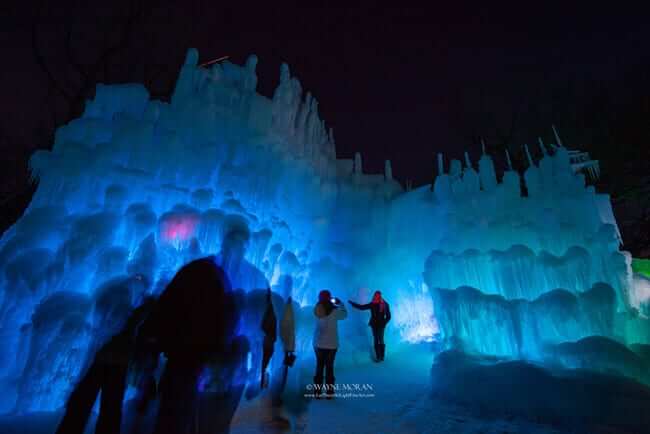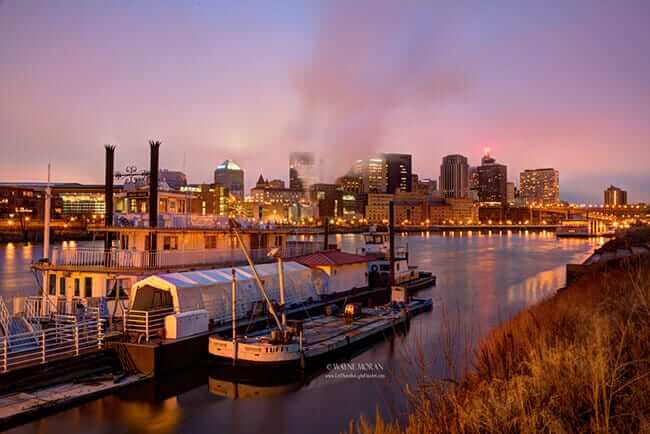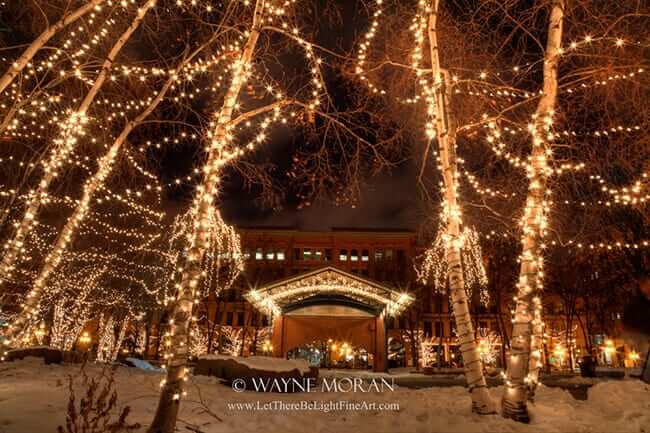Winter Landscape Photography by Printique Ambassador Wayne Moran of Let There Be Light Fine Art Photography.

Fine Art Landscape and Architecture Photography
Protect Yourself
The most important thing to figure out is how to stay warm so that you can enjoy yourself while out shooting on very cold days. Staying warm, dry and comfortable is the secret to enjoying outdoor adventures in the winter.
Hand Warmers
I am going to be mentioning these several times, so I want you to know exactly what I am talking about. Hand warmers are little packages of chemicals that react to the moisture of your body, creating instant heat which lasts several hours.
This chemical reaction produces heat. And that heat is oh so heavenly.
Dress in Layers
Always dress in layers of clothing, using wool or one of the latest modern high-tech fibers that aid in the retention of body heat.
Must have Great Boots
Make sure you have good quality boots that are warm and if possible, waterproof. If possible, use toe warmers in your boots. Be sure you have great socks that are warm and breathe well. You must keep your feet warm and dry so that you are comfortable for up to several hours.
Sweaters and More
Be sure you wear a breathable sweater made out of wool or modern wicking materials. While you are out shooting you will warm up, and most likely work up a sweat. You need to be able to stay dry, or you will be getting very cold later.
Mittens or Gloves
Great mittens or warm gloves are vital in cold weather, possibly with a removable index finger so that you can easily shoot.
Whenever it is below 30 degrees Fahrenheit, I always have hand warmers in my gloves. Since I normally take my gloves off and on several times throughout the outing, it’s great to have hand warmers inside my gloves so they are quite warm when your hand goes back in. It’s important that your hands remain warm and dry while working so that you’re able to manipulate your camera as well as change the settings while staying warm and comfortable throughout the adventure.
The Camera
Most cameras are relatively well-sealed these days, so, for the most part, you don’t have to worry about them getting cold or moisture seeping inside them. Just be careful not to drop them in a snowbank or anything like that.
However, when you bring a very cold camera into a warm, moist building, you can have a problem with moisture. When you are bringing your camera back indoors after shooting in cold weather, consider doing so in steps, so it will be gradually warmed up. For example, if you are outside in 0 degrees F temperatures, maybe leave your camera in a 50 degrees F garage for an hour or so, then bring it inside and let it slowly get to room temperature before turning it on. Also, open it up to make sure it is warm and dry before you turn it on again.
The Battery
You do have to worry about how the cold affects your camera’s battery. Your battery will run down much more quickly in the cold. So either have backup batteries, or make sure you have a larger battery pack.
I have been shooting in the winter for many years, and have never damaged any camera while out in the snow and cold. Unless you drop your camera in the snowbank, you’ll probably be quite safe capturing gorgeous winter scenery
Surviving Ice
One of the biggest challenges of winter can be the environment in which you are walking. In winter conditions, quite often the beautiful places like lakes, ponds, and waterfalls are frozen. These scenes can be shockingly beautiful and unique because they look like they are from another world. However, this ice can be extremely treacherous. In my early years, I have been out on the ice and fallen multiple times because it is just so slippery. Ice can go from very rough with great traction to silky smooth where there is no traction. Before you know it, you and the ice are one, and you are on your backside. While that may be okay if you are simply hiking, if you are carrying heavy expensive camera gear, this can easily become a tragedy.
So what is the solution? My suggestion is to invest in some crampons or ice grippers. I am amazed it took me so long to get a pair, but they are quite literally lifesavers. They are simple devices with a rubber slipper-like form that fits around your shoe/boot that have chains and cleats on the bottom, providing amazing traction.
I love the FreeSteps6 from Hillsound Equipment. They are affordable, easy to use and fabulous. They saved my life.
Having great boots is one thing, but if you are hiking in relatively deep snow, that snow can get into your boots and you end up wet and cold, in spite of having good equipment. One way to solve this problem is to buy a great set of gaiters. Take my advice: you’ll want some high-tech ones that are easy to use, lightweight, and waterproof.
The Hillsound Super Armadillo Gaiters are the ones I love the best!
Light Metering
One of the most challenging things in winter is achieving the correct exposure. All camera metering systems are calibrated to base exposure on neutral tonality or neutral gray. White, snow-covered landscapes will influence and most likely dominate your camera meter’s exposure reading. Consequently, solely relying on the camera’s meter to set exposure may lead to disappointing results when you discover that all your snow-covered winterscapes are underexposed and appear a dull gray. While this might be the mood you’re trying to capture, you normally would expect snow to appear white regardless of lighting conditions.
Metering Compensation
With this knowledge of how the meter functions, it’s then a simple matter to achieve correct exposure by adding positive compensation (overexposure). I find that even on an overcast day, or in shade, a snow-covered scene will need to be overexposed by +1 stop, or exposure value (EV). Bright sunlit snow scenes may require +2 EV. Be very careful at going beyond +2 EV compensation, though, as things will start to become blown out with loss of detail.
Exposure Bracketing
Another way to handle this if you are shooting a landscape on a tripod is to be using the function Auto Exposure Bracketing (AEB). Most people that are doing any sort of exposure blending are already doing this, so you will be capturing a much larger range of exposure so you can blend the images in post-production.
Shooting in RAW
In addition, make sure you are shooting in RAW so that you are capturing much more image data at the time of shooting to enable easy adjustments to exposure when you are processing the RAW image.
You can check out THIS VIDEO if you have no idea what I am talking about with concern to Auto Exposure Bracketing and merging images.
It is Off–Season for National and State Parks
Parks Are Open
The vast majority of national and state parks are indeed open in the winter. If you’re a hearty outdoors person, you can spend time camping, which would give you all kinds of great photographic opportunities.
Easier to Capture Sunrise and Sunset
One of the really great things about winter is that the days are much shorter. What that means is you don’t have to get up so early to catch the sunrise, and you don’t have to stay up so late to catch the sunset.

Fine Art Landscape and Architecture Photography

Since there are fewer photographers that are willing to capture interesting events, you have a greater opportunity to capture a unique winter image, simply because you are there. As you venture out capturing images of local events, the event sponsors, in an effort to publicize their events might request use of your photos. That is exactly what happened to me recently.